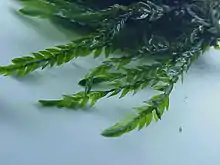Fontinalis antipyretica
Fontinalis antipyretica, [2] greater water-moss,[3] or common water moss, is a species of submerged aquatic moss belonging to the subclass Bryidae. It is found in both still and flowing freshwater in Europe, Asia, Greenland and Africa. In North America it is found in most Canadian provinces with a seaboard and most US states except the most southern.[4]
| Fontinalis antipyretica | |
|---|---|
 | |
| Scientific classification | |
| Kingdom: | Plantae |
| Division: | Bryophyta |
| Class: | Bryopsida |
| Subclass: | Bryidae |
| Order: | Hypnales |
| Family: | Fontinalaceae |
| Genus: | Fontinalis |
| Species: | F. antipyretica |
| Binomial name | |
| Fontinalis antipyretica | |
Description

in Flora Batava, 1846
F. antipyretica[lower-alpha 1] has branched, trailing stems that are triangular in cross-section and may be as long as 60 cm (24 in). The leaves are quite stiff and are arranged in three overlapping rows. Each leaf is lance-shaped or egg-shaped, with a keel and a sharp point, some 4 to 9 mm (0.16 to 0.35 in) long. There are no flowers but minute spores are sometimes produced in smooth sporangia (capsules) between 2 and 2.6 mm (0.08 and 0.10 in) long.[5]
Distribution and habitat
F. antipyretica is found in Europe, Asia and parts of Africa. It grows attached to submerged rocks in fast-flowing water. It also occurs attached to the substrate in lakes and as floating masses in still water, and may be cast up on beaches at the waterside.[5] It thrives in shady positions and prefers acid water, a pH of around 8.4 being the maximum tolerated.[5] It is replaced in highly acid mountain and moorland streams in the UK by Fontinalis squamosa.
Biology
Reproduction is mostly by stolons or by the rooting of detached fragments. Sexual reproduction does also occur, in the spring in North America, but is relatively unimportant as a means of reproduction. Individual plants are either male or female and the capsules housing the spores are seldom observed.[6]
Ecology
F. antipyretica grows in large clumps and mats and provides refuge for fish eggs and fry.[6] Numerous invertebrates shelter among the fronds; Chironomid larvae hide in the bases of the leaves and mayfly, caddisfly and stonefly larvae cling to the fronds, and in fast-flowing water black fly larvae are often present.[6] Diatoms and other microscopic algae grow epiphytically on the fronds.[6]
Heavy metal adsorption
It has been found that F. antipyretica can adsorb cadmium and zinc, with maximum biosorption of cadmium being 28 milligrams (0.43 gr) per gram of dried moss, and of zinc 11 to 15 milligrams (0.17 to 0.23 gr) (depending on water temperature). The biosorption of cadmium was unaffected by the hardness of the water but that of zinc was affected by rising calcium levels.[7]
Aquarium uses
F. antipyretica was traditionally used in cool-water aquaria,[8] but in tropical aquaria the similarly structured "Java moss" ( a Vesicularia species) takes its place.
Notes
- The name is new Latin, from Latin fons, spring (of water), anti, against, and Greek πυρ (pyr), fire, meaning "the water moss that stops fire", because of its use in medieval europe to extinguish fires.
References
- Vandepitte, Leen (2014). "Fontinalis antipyretica Hedw". WoRMS. World Register of Marine Species. Retrieved 2015-01-29.
- "Fontinalis antipyretica". Natural Resources Conservation Service PLANTS Database. USDA. Retrieved 4 February 2016.
- Edwards, Sean R. (2012). English Names for British Bryophytes. British Bryological Society Special Volume. 5 (4 ed.). Wootton, Northampton: British Bryological Society. ISBN 978-0-9561310-2-7. ISSN 0268-8034.
- "Fontinalis antipyretica". Flora of North America. Retrieved 13 October 2020.
- "Fontinalis antipyretica Hedw.: Common water moss". Washington State Department of Ecology. Archived from the original on 2015-02-15. Retrieved 2015-01-28.
- Janice M. Glime. "Fontinalis". University of Massachusetts Amherst. Archived from the original on 2012-02-24. Retrieved 2015-01-28.
- Martins, R.J.; Pardo, R.; Boaventura, R.A. (2004). "Cadmium(II) and zinc(II) adsorption by the aquatic moss Fontinalis antipyretica: effect of temperature, pH and water hardness". Water Research. 38 (3): 693–699. doi:10.1016/j.watres.2003.10.013. hdl:10198/2001. PMID 14723939.
- William T. Innes, Exotic Aquarium Fishes, 19th ed. 1965:88.